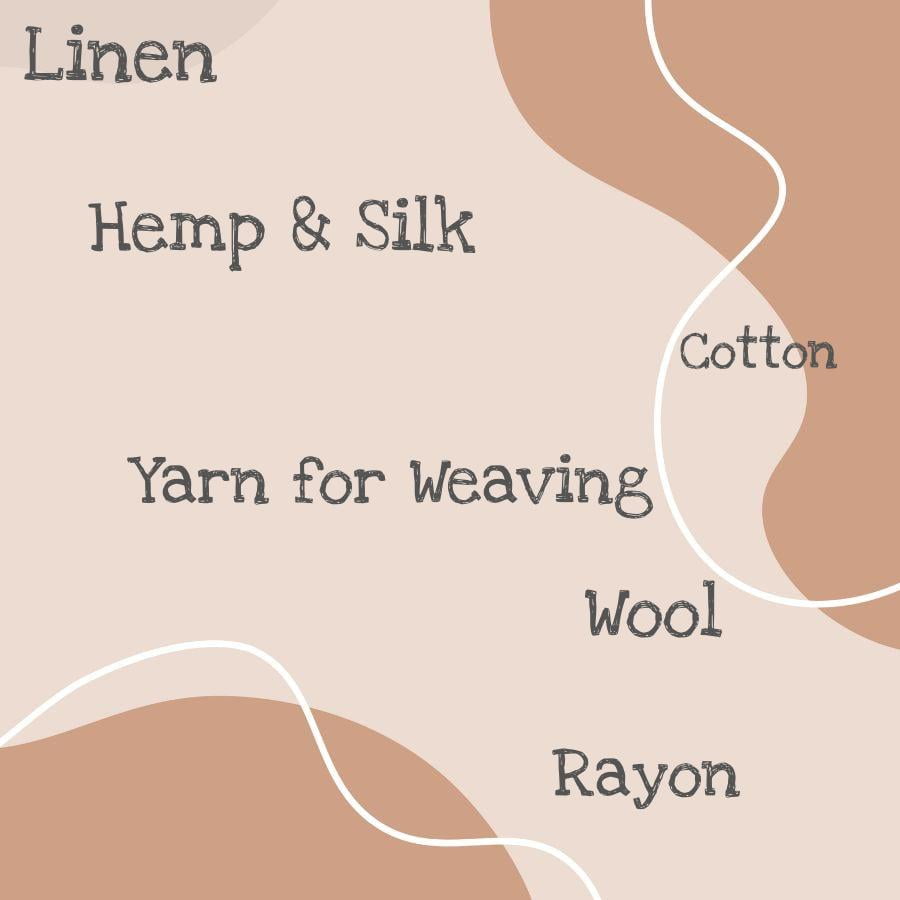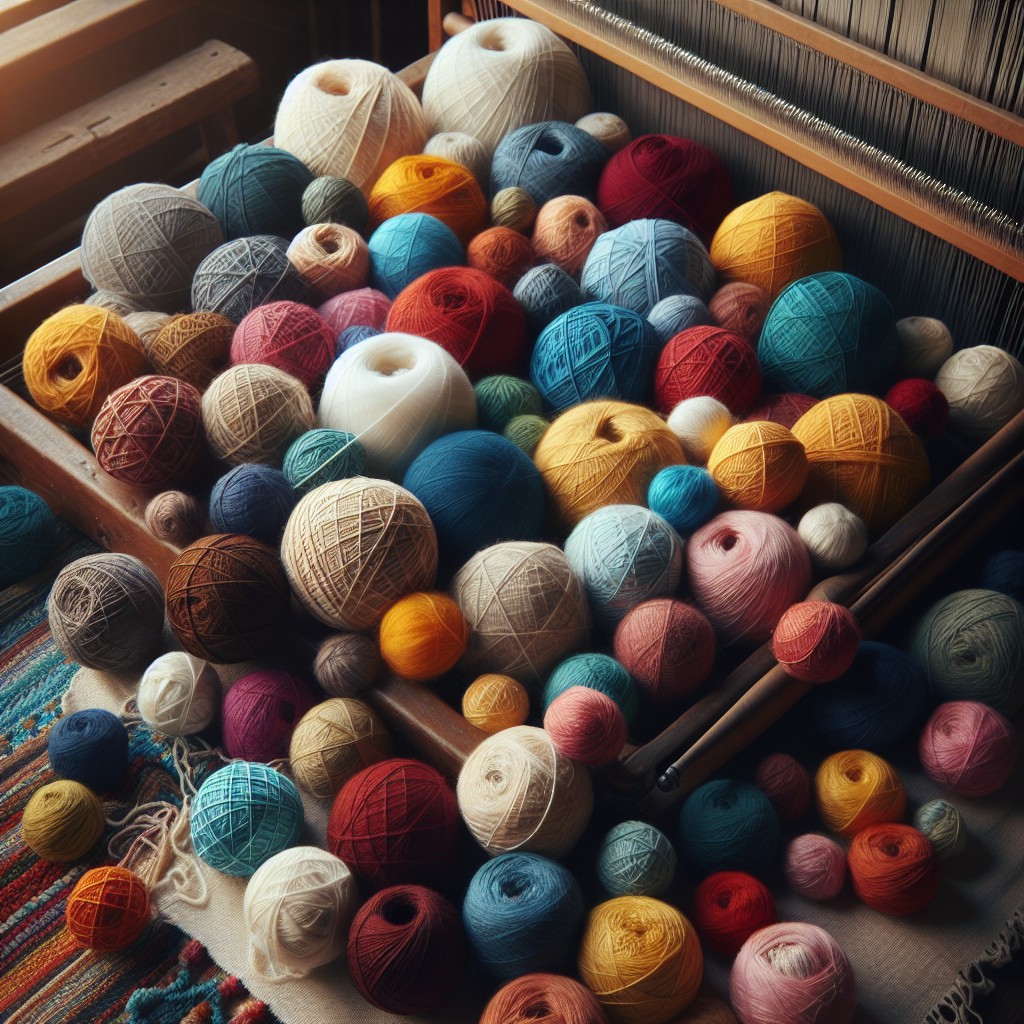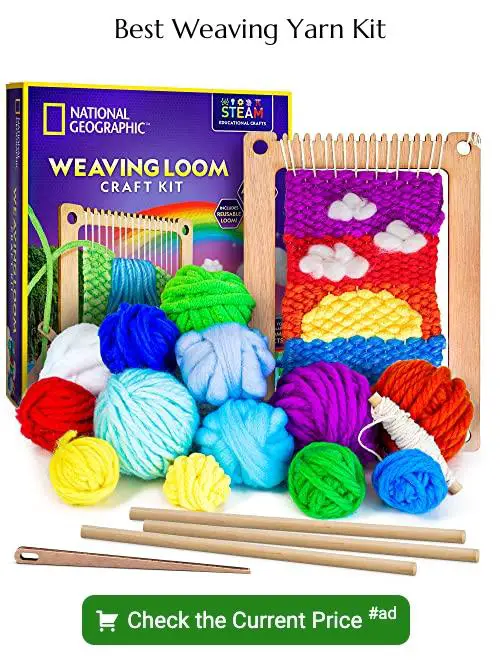Discover the diverse range of yarn types perfect for weaving, as we delve into their unique characteristics and applications in creating stunning textile masterpieces.
Weaving is an ancient art that has been practiced for thousands of years, and it still holds a special place in the hearts of many crafters today. One of the most important aspects of weaving is choosing the right type of yarn to use.
With so many different types of yarn available on the market, it can be overwhelming to know where to start. But fear not! In this article, we will explore some of the most popular types of yarn for weaving and help you choose which one is best suited for your next project.
Whether you’re a seasoned weaver or just starting out, this guide will give you all the information you need to create beautiful and unique woven pieces that are sure to impress. So let’s dive in!
Wool

It’s a versatile fiber that comes in many different textures and colors, making it perfect for creating a wide range of woven pieces. Wool is also known for its warmth and durability, which makes it an excellent choice for items like blankets or rugs.
When choosing wool yarns for weaving projects, there are several factors to consider. The weight or thickness of the yarn will affect how dense your weave will be; thicker wool creates more substantial weaves while thinner ones produce lighter fabrics with more drape.
Another important consideration when working with wool is its felting properties. Felting occurs when fibers become entangled through heat or agitation resulting in shrinkage; this can happen during washing if not handled correctly.
Silk

It is known for its lustrous sheen, softness, and strength. Silk yarns come in a variety of weights and textures, making them suitable for many different types of projects.
When it comes to weaving with silk yarns, there are some things to keep in mind. Silk can be slippery when working with it on the loom or warping board so you may need to take extra care when winding your warp or threading your heddles.
One popular type of silk yarn used by weavers is called “spun silk.” This type of silk has been processed into a smooth thread that can be easily woven into fabric. Spun silks come in various thicknesses from fine lace weight up through bulky weight suitable for rugs.
Another option is “noil” or raw silk which has more texture than spun silks due to the short fibers left after processing cocoons into filament threads (used mainly as weft). Noil also tends not to slip as much during handling compared with other types of silks making it easier workable on the loom especially if you’re new at this craft!
Cotton

It’s affordable, widely available, and comes in a variety of colors and textures. Cotton yarns are perfect for creating lightweight fabrics that are breathable and comfortable to wear.
They’re also great for making dishcloths or other household items because they’re absorbent.
When choosing cotton yarns for weaving projects, consider the weight (thickness) of the yarn as well as its texture. Mercerized cotton has been treated with chemicals to give it a lustrous sheen while unmercerized cotton has a more matte finish.
One thing to keep in mind when working with cotton is that it tends to shrink when washed or exposed to moisture. To avoid this issue, pre-wash your skeins before starting your project so you can accurately gauge how much shrinkage will occur.
Linen

It’s made from the fibers of the flax plant, which are spun into yarn and then woven into fabric. Linen has a distinctive texture that gives it a rustic look, making it perfect for creating home decor items like tablecloths, napkins, and curtains.
One of the benefits of using linen in weaving is its strength. Linen fibers are some of the strongest natural fibers available on the market today.
This means that any fabric created with linen will be durable enough to withstand regular use without showing signs of wear or tear.
Another advantage is its absorbency; linen can absorb up to 20% moisture before feeling damp or wet! This makes it an excellent choice for towels or other items where moisture absorption is important.
When working with linen yarns in weaving projects, keep in mind that they tend to have less elasticity than other types such as cotton or wool. Therefore warping may require more attention when setting up your loom.
Hemp

It’s known for its durability, strength, and resistance to mold and mildew. Hemp yarns are perfect for weaving projects that require sturdiness such as bags, rugs or even clothing items like jackets.
One of the unique characteristics of hemp yarn is its natural color which ranges from creamy white to dark brown depending on how it was processed. The texture can also vary from smooth to slightly rough giving your woven piece an interesting tactile quality.
When working with hemp yarns it’s important to note that they tend to be stiff at first but soften up after washing or use over time. They’re also prone to shedding during the weaving process so make sure you have a lint roller handy!
Rayon
It’s made from wood pulp, making it a natural fiber that has the look and feel of silk. Rayon yarns come in various weights, including lace weight, fingering weight, sport weight, and worsted weight.
One of the benefits of using rayon yarn is its drapeability. This makes it perfect for creating flowing garments such as shawls or scarves that will hang beautifully when worn.
Rayon takes dye well which means you can create vibrant colors with ease.
When working with rayon yarns on your loom be sure to use a sett (the number of warp threads per inch) appropriate for your project needs as they tend to have less elasticity than other fibers like wool or cotton.
Soy
Made from soybean protein fiber, this type of yarn is sustainable and biodegradable. Soy yarn has a soft and silky texture that makes it perfect for creating lightweight garments like scarves or shawls.
One of the unique characteristics of soy yarn is its ability to absorb dye well, resulting in vibrant colors that don’t fade easily. It’s also naturally hypoallergenic and resistant to mold and mildew.
When using soy yarn for weaving projects, keep in mind that it can be more delicate than other types of fibers like wool or cotton. This means you may need to adjust your tension settings on your loom accordingly.
Acrylic
It’s made from synthetic fibers, which means it’s easy to care for and can be machine washed without losing its shape or color. Acrylic yarn comes in a wide range of colors, making it perfect for creating vibrant woven pieces that pop.
One of the benefits of using acrylic yarn is that it has excellent drape, which makes it ideal for weaving scarves, shawls, and other garments. It also works well as an accent or border on larger projects like blankets or tapestries.
When working with acrylic yarns on your loom project consider using a sett (the number of warp threads per inch) between 8-12 epi (ends per inch). This will give you good coverage while still allowing the fabric to breathe.
Metallic
These yarns come in various shades, from gold and silver to copper and bronze, making them perfect for creating eye-catching designs that stand out. Metallic yarn can be made from different materials such as polyester or nylon with metallic coatings or metal fibers like aluminum, brass, or copper.
When using metallic yarn in weaving projects, it’s important to keep in mind that they tend to be stiffer than other types of thread due to their composition. This stiffness can make them more challenging when working on intricate patterns but also makes them ideal for structural elements like borders.
One thing weavers should note is the care instructions when washing items made with metallic threads since some may not hold up well under certain conditions such as high heat settings during laundering cycles.
Warping Suggestions for Different Skill Levels & Loom Types
It’s what you weave your weft through and ultimately creates the structure of your piece. Warping can be a daunting task for beginners, but with practice and patience, it becomes second nature.
For those just starting out with a rigid heddle loom or table loom, using pre-measured warps can make things easier. These are often available in kits that include everything you need to get started.
As you become more comfortable with warping and move on to larger floor looms or more complex patterns like doubleweave or overshot, measuring out longer lengths of warp becomes necessary. This requires some basic math skills but there are plenty of resources available online that can help simplify this process.
Workhorse Yarns: Cotton, Wool & Rayon (bamboo)
These include cotton, wool, and rayon (bamboo).
Cotton is a popular choice for weavers because it’s easy to work with and comes in many different colors. It’s also strong enough for warp threads but soft enough for weft threads.
Wool is another great option as it has natural elasticity which makes it perfect for creating textured fabrics like tweed or boucle. Rayon (made from bamboo) is also becoming increasingly popular among weavers due to its silky texture and drape.
These three yarns are often used together in projects as they complement each other well – cotton provides structure while wool adds warmth, and rayon brings an elegant sheen.
Intermediate to Advanced Yarns: Linen, Hemp & Silk
These fibers require more skill in handling due to their delicate nature but can produce stunning results when woven correctly.
Linen is known for its strength and durability. It has been used for centuries in the production of textiles due to its ability to withstand wear and tear.
Linen also has a unique texture that adds depth and interest when woven into fabric.
Hemp is another strong fiber that produces beautiful results when woven into fabric. It’s an eco-friendly option as it requires less water than cotton during cultivation.
Silk is perhaps the most luxurious of all fibers used in weaving. Its natural sheen gives any project an elegant touch while also being incredibly soft on the skin.
When working with these intermediate-to-advanced level yarns, it’s important not only to have experience with basic weaving techniques but also knowledge about how each fiber behaves on different looms or warping methods.
Advanced and Experimental: Tape, Paper, and Novelty Yarns
These unconventional materials can add texture and dimension to your woven pieces in ways that traditional fibers cannot. Tape yarns are flat ribbons made from various materials such as cotton or polyester, which can be used for both warp and weft threads.
Paper yarn is another unique option that adds an interesting element to any project with its delicate yet sturdy nature.
Novelty yarns come in all shapes and sizes – from fluffy boucle to metallic thread – making them perfect for adding pops of color or sparkle into your work. However, it’s important to note that these types of specialty fibers require extra care when handling due their fragility.
Weaving With Fabric
It’s also an excellent way to use up scraps of fabric that you may have lying around. When weaving with fabric, it’s important to choose fabrics that are not too thick or heavy, as they can be difficult to weave through the warp threads.
To get started, cut your chosen fabrics into strips about 1-2 inches wide and as long as you need for your project. You can use a variety of different types of fabrics such as cotton, silk or even jersey knit.
When weaving with fabric strips, it’s best practice not only interweave them but also alternate between using yarns in the weft rows so that there is enough tension on both sides while keeping the edges straight. Using different colors and textures will create unique patterns in your woven piece which makes this technique perfect for creating one-of-a-kind wall hangings or table runners.
Miniature Coiling
This method is perfect for creating delicate and detailed pieces such as jewelry, ornaments, and even miniature baskets. To create these tiny masterpieces, you will need a needle with an eye large enough to accommodate your chosen yarn or thread.
Start by wrapping the end of your yarn around the needle several times to form a small coil. Then use your fingers to gently push the coil down towards the base of the needle until it forms a tight spiral shape.
Next, take another piece of yarn and wrap it tightly around one side of the spiral while holding onto both ends with your other hand. Continue wrapping in this manner until you have covered all sides evenly.
As you work on each row, be sure to keep pushing down on previous rows so that they remain tightly packed together without any gaps between them.
With practice and patience (and perhaps some magnifying glasses!), anyone can learn how to create beautiful miniature coiled designs using just their hands and some simple tools!.
FAQ
What type of yarn is best for weaving?
The best type of yarn for weaving is cotton and wool, as they are easy to work with, tension while warping, and suitable for beginner weavers.
Do you need special yarn for weaving?
Answer: No, you do not need special yarn for weaving as you can use knitting yarn for weaving purposes.
Can I use any yarn for weaving?
Answer: Yes, you can use any yarn for weaving, but having knowledge about specific yarns and their purpose will lead to more successful knitting and weaving projects.
What is weaving yarn called?
The weaving yarn is called warp and weft, with warp being the lengthwise yarns held stationary in tension on a loom and weft being the transverse yarns drawn through and inserted over and under the warp.
What are the differences between various yarn materials used in weaving?
Yarn materials differ in their texture, durability, and warmth, as wool provides insulation, cotton is soft and breathable, silk adds luxuriousness, while synthetics offer affordability and versatility.
How do I choose the right yarn thickness for my weaving project?
To choose the right yarn thickness for your weaving project, consider the desired fabric density, project type, and loom’s capabilities, and select a yarn that meets these requirements.
Are there eco-friendly yarn options for sustainable weaving practices?
Yes, there are eco-friendly yarn options such as organic cotton, linen, and bamboo for sustainable weaving practices.





